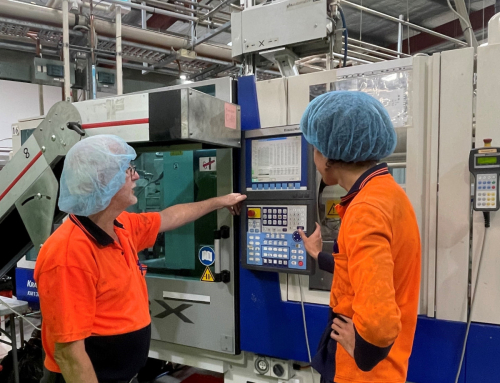In today’s world of advanced manufacturing, precision and cleanliness are more than just quality control measures – they are necessities, particularly for critical products such as medical devices or sensitive electronics. At W&S Plastics we maintain contamination-free environments for our operations, and have established ourselves as a manufacturing leader in Australia and Malaysia through our state-of-the-art cleanroom technology.
The Cleanroom Advantage: Australia and Malaysia
W&S Plastics operates cleanrooms in both Australia and Malaysia, with each facility designed to meet stringent international cleanroom classifications.
In Australia, our facility features a sterile ISO Class 7 Cleanroom and an ISO Class 7 Clean Moulding Cell and our general working environment operates at ISO Class 8 particulate levels. These controlled environments are essential for products that require high cleanliness and sterility, including medical devices and sensitive electronics.
In Malaysia, we operate two cleanrooms: an ISO Class 8 Cleanroom for our Plastic Injection Moulding factory and an ISO Class 7 Cleanroom for assembly operations. These cleanrooms have advanced systems and protocols that meet the highest contamination control standards.

ISO 8 Cleanroom – used for injection moulding production
Why Certain Products Need Cleanrooms
Not all products require such rigorous standards, but for those that do, cleanrooms are indispensable. The cleanrooms in our Australian and Malaysian facilities enable us to manufacture products such as:
- Medical devices and pharmaceutical tools that interact with the human body and must remain sterile.
- Optical devices and sensitive electronics that require protection from particulate matter, dust and foreign chemicals.
- Sterile packaging and cleanroom clothing, which must be free from bacterial and viral pathogens.
Our controlled environments ensure that products meet the highest standards of cleanliness, essential for industries where contamination can have serious consequences.
Behind the Scenes: How Our Cleanrooms Work
The design of our cleanrooms is key to maintaining a contamination-free environment. Each cleanroom operates with air-locks, creating a series of controlled rooms that serve as barriers between the external atmosphere and the working space.
Inside, positive pressure filtration systems are employed to ensure that filtered air is constantly pumped into the cleanrooms, keeping them cleaner than the surrounding environment. This pressure prevents contaminants from entering the cleanroom, even when personnel or products are moved in and out.

Gauge monitoring positive pressure
Our cleanrooms also have HEPA filters (High-Efficiency Particulate Air) that cycle air multiple times per hour, trapping even the smallest particles. Air showers are also installed to flush away particles from personnel and materials before they enter the cleanroom.

Air shower units located before cleanroom entry
Monitoring and Control
Maintaining such high standards requires constant vigilance. In our Malaysian cleanrooms, we use a Lighthouse Handheld Particle Counter, a portable device that measures dust particles, temperature and humidity at 36 locations throughout the cleanrooms.

Particle counter for monitoring particles in cleanrooms
Monitoring is conducted weekly for the ISO 7 Cleanroom and monthly for the ISO 8 Cleanroom, ensuring that environmental parameters remain within strict limits.
In addition, pressure gauges located near the entrance doors continuously monitor the positive pressure within the cleanrooms, ensuring that outside contaminants are kept at bay.

ISO 7 Cleanroom – used for assembly production
Keeping It Clean: Rigorous Cleaning Procedures
At our Malaysian facility, maintaining a clean environment is a 24/7 effort. Daily cleaning procedures include mopping floors, vacuuming with HEPA-filtered equipment, and wiping down surfaces with antiseptic chemicals. Work areas are cleaned at the end of each shift, and weekly deep cleans involve wiping walls with distilled water, vacuuming dry, and cleaning windows and pass-throughs.
We also change sticky mats placed outside the gowning room and at the cleanroom entrance twice per shift to prevent external contaminants from entering. Regular maintenance checks of the HVAC system and annual replacement of the HEPA filters further ensure that the cleanrooms remain in optimal condition.
Handling Materials with Care
Material handling is crucial to maintaining the integrity of our cleanroom environments. All materials entering the cleanroom are double-bagged, with the outer bag removed in a controlled room (known as the Kitting Room) before the clean inner bag is transferred into the cleanroom. Cardboard and wood are strictly prohibited, as they could introduce contaminants. Raw materials, such as resin, are stored in our warehouse and transported through hopper dryer systems into the cleanroom injection machines, all while following strict hygiene protocols.
Staff Training and Protocols
Operating in a cleanroom requires specialised training. New employees undergo a detailed induction process covering the Do’s and Don’ts of working in cleanrooms. Work Instructions are displayed in the gowning room, guiding staff through the proper gowning and de-gowning procedures required to maintain sterility.
These instructions ensure that everyone follows the correct steps, and regular retraining sessions help reinforce best practices. Employees are kept informed of the results of the weekly monitoring counts, ensuring that areas requiring extra attention are improved.
Meeting Growing Demands
At W&S Plastics, our cleanroom capabilities reflect our commitment to maintaining the highest standards of cleanliness and precision.
Our Australian cleanroom was developed in response to local customer demand, ensuring that we can provide assembly services in a sterile environment to match the clean moulding operations already in place.
Customers can consult with our team to review the cleanroom-certified equipment and assembly processes used in both our Australian and Malaysian facilities.
From start to finish, we work closely with clients to ensure their projects meet the exacting standards required by cleanroom environments.
Contact us today to find out more.







